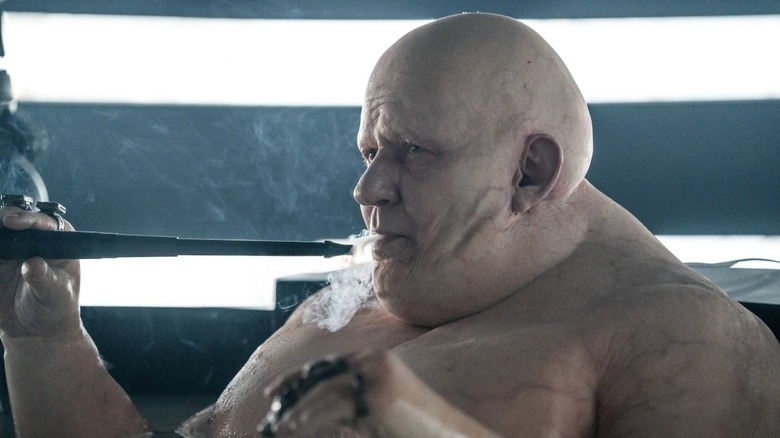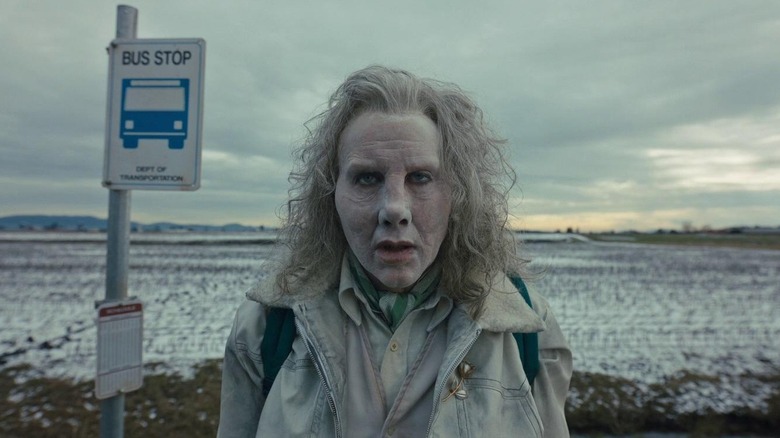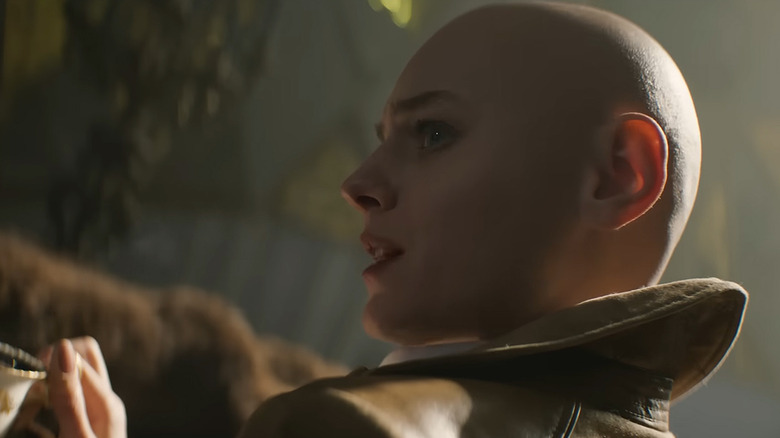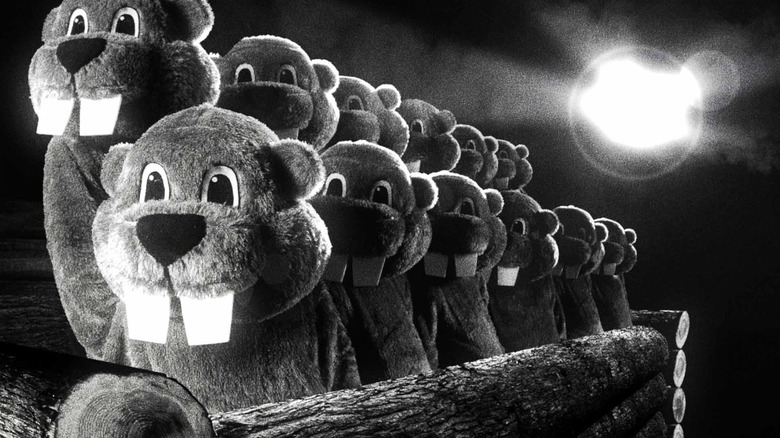Villains Who Died In 2024
Villains. For on-screen heroes, they're a tremendous burden that threatens the world they inhabit and provides endless obstacles. For moviegoers everywhere, though, the best movie villains can be captivating figures that you just love to hate. Sometimes, a great big-screen baddie is someone you get unexpectedly emotionally invested in. Others are just scheming evildoers that are just so enthralling to watch. In many cases, the inevitable dethroning of villains inspires mild disappointment in audiences simply because they're so enjoyable. But that's the inevitable outcome for so many individuals determined to kill the innocent or take over the world.
Villains tend to perish in mainstream movies and 2024 has been no exception. This year's various films have featured many antagonists who, despite all their best efforts, couldn't evade the inescapable specter of death. These villains emerged in a wide array of movies. Some of them inhabited superhero yarns, a domain that's rife with vivid villains that everyone adores. Others were more grounded foes inhabiting stories about serial killers or corrupt politicians. These villains reminded audiences everywhere of real-world terrors from their own backyard. Still other cinematic villains in 2004 were literally hordes of woodland critters determined to kill a plucky woodsman.
There were many ways villains manifested in 2024 movies. Ditto the ways they died, which ranged from brutal product placement to a hero tragically becoming evil. Thanks to all these adversaries who died in 2024, audiences were reminded how unavoidable death is, even for your typical pop culture villain.
Ezekiel Sims in Madame Web
Ezekiel Sims (Tahar Rahim), the villainous centerpiece of many of the worst moments in "Madame Web," does not pursue a life of evil to get an Infinity Stone or rule the world. Instead, he's simply trying to prevent his own demise. After experiencing a vision of the future where three super-powered ladies kill him, Sims dedicates the remainder of his life to snuffing out these women before they even become crime fighters. To accomplish this, he dons a super-suit that looks a lot like a black-colored version of Spider-Man's outfit and pursues three New York teenagers in the year 2000, intent on averting his own death.
Alas, unbeknownst to Sims, he's a villain in a superhero movie. Save for the occasional Thanos or Darkseid, these figures are usually one-and-done characters. Seminal comic book baddies like Ronan the Accuser or Two-Face usually only show up for one movie before perishing in their big-screen incarnations, so Sims never has a chance of surviving. In the climax of "Madame Web," Sims attempts to eliminate these teenagers once and for all, only for the clairvoyant Cassandra Webb (Dakota Johnson) to eventually stop him. Her protection of these teens leads to Sims perishing once Webb drops a gigantic Pepsi billboard on him. A super-powered man who relentlessly tries to avoid his own death is eventually killed ... but the movie itself dies long before that.
Sentinel Prime in Transformers One
If Sentinel Prime shows up in a theatrical "Transformers" movie, chances are he's a nefarious villain posing as a legendary hero and close ally to Optimus Prime. This moral affiliation from 2011's "Transformers: Dark of the Moon" is mimicked in 2024's "Transformers One," where Sentinel Prime (Jon Hamm) is depicted as a legendary savior on Cybertron, a figure that every robot looks up to. That includes Orion Pax (Chris Hemsworth) and D-16 (Brian Tyree Henry), who are in awe of his bravery. Eventually, though, they discover that Sentinel Prime is a traitor to Cybertron. Rather than defending the planet from evildoers, Sentinel Prime is working with the wicked aliens the Quintessons. He's also actively maintained a hierarchal structure on Cybertron and removed the transforming cogs from many of the planet's various denizens.
Orion Pax and D-16 are both crushed by this news, though they each process their pain in starkly different ways. Pax wants to help the oppressed Cybertronian robots rise up and take control of their destiny. D-16, meanwhile, wants to exact violent revenge on Sentinel Prime. He eventually gets his wish in a critical sequence showing D-16, despite Pax's protests, slaughtering an unarmed Sentinel Prime (by ripping him in half) in front of a crowd of robots. This brutal behavior solidifies D-16's descent into becoming Megatron while also explicitly showing that the former ruler of Cybertron is now a hunk of junk. But even with Sentinel Prime gone, an evil new robot has risen.
Skar King in Godzilla x Kong: The New Empire
In their first big American team-up movie, Godzilla and Kong eventually put aside their differences to fight MechaGodzilla, a mechanical variation on the big lizard. For "Godzilla x Kong: The New Empire," director Adam Wingard has these colossal creatures duke it out with a wicked parallel to Kong. That figure manifests as Skar King, a massive red ape whose evilness stretches back to before the first ice age. Living in the bowels of Hollow Earth, Skar King commands both a gorilla army and the ice-breathing creature known as Shimo. Thanks to Shimo, Skar King is able to temporarily defeat Kong and pursues a plan of causing mayhem on the surface world.
In his physicality, Skar King is a ganglier creation than either Godzilla or Kong. He doesn't have gigantic muscles, but he's a svelte fighter with persistence and nimbleness to spare. Those attributes, not to mention his using a crystal to control Shimo, prove incredibly handy once he begins exacting his grisly revenge on ordinary humans in Rio de Janeiro. This ancient adversary is so mighty that it takes more than just two Titans to wipe him out. Mothra and a freed Shimo eventually prove essential to stopping Skar King. The ape's final demise comes once Shimo freezes him, leading Kong to decimate the mighty simian. With that, the latest villain uniting Godzilla and Kong perishes, but not after leaving an enormous impact on monsters and humans alike.
The symbiote in Venom: The Last Dance
Is Venom a villain? An anti-hero? In terms of his moral affiliations, this comic book fixture is about as slippery as the gooey symbiote himself. Whatever he is, though, he's certainly not a straight-up superhero and he's unquestionably been a villain across many different comic books, TV shows, and movies. However, in "Venom: The Last Dance," the symbiote does part with Eddie Brock (Tom Hardy) and perform at least one noble sacrificial action.
This bold move comes when Venom and Eddie realize that there is only one way to stop the otherworldly xenophage...and it requires Venom to function as bait. Against Eddie's protests, Venom sacrifices himself in a massive acid shower to ensure that the xenophage is destroyed and can't repair itself. While the symbiote informs Eddie that this isn't goodbye forever, Venom still dies in "The Last Dance."
With Venom deceased, the trilogy comes to a bittersweet close as Eddie travels to New York City (a place Venom always wanted to visit) and remarks that he'll never forget his monstrous pal. It's true that, over the course of these three "Venom" movies, the symbiote and Eddie team up to do some very bad things. Still, die-hard fans of the "Venom" movies undoubtedly shed some tears witnessing Venom's sacrifice, an admirable act from an often unsavory character.
Baron Vladimir Harkonnen in Dune: Part Two
No matter what your societal status, life can throw any of us for incredible loops. One minute you're up, the next minute you're so far down on the ground you can see every crack in the tile flooring. So it is with Baron Vladimir Harkonnen (Stellan Skarsgård) in "Dune: Part Two," a figure of tremendous stature and power in the "Dune" universe. This man, who spends his days bathing in oil and lounging while watching folks dismember each other, wields incredible power as House Harkonnen's leader.
This is demonstrated in the first "Dune," which finds Harkonnen ordering an attack on House Atreides to ensure control of the Arrakis spice trade. This vicious maneuver inspires a lust for vengeance in the heart of Paul Atreides (Timothee Chalamet). After nearly six hours of screentime, the ending of "Dune: Part Two" sees Paul exacting revenge for the demise of his father and countless other souls.
After leading a battle as Lisan al Gaib, Paul makes his way into a room containing Baron Harkonnen, a man he recently learned is his grandfather. He then stabs the battered Harkonnen and declares, "You die like an animal." The death of Baron Harkonnen under these circumstances isn't just meaningful because it shows that someone so powerful was still vulnerable. It's also a sign of Paul further descending into the darkness. Rather than living up to his birth father's ideals, Paul is becoming more and more like the grisly ruler he slaughters.
Longlegs in Longlegs
Nicolas Cage as the title character in "Longlegs" was, without question, one of 2024's most frightening creations. An inexplicable entity prone to acts of evil and bizarre singing, Cage's dedicated performance and the patient filmmaking of director Osgood Perkins really make this guy terrifying rather than unintentionally hysterical. A pastiche of countless real-world serial killers, Longlegs leaves a lengthy string of bodies behind him ... despite there never being any evidence of him actually being in the house of his victims when they die.
It's an inexplicable phenomenon driving FBI agent Lee Harker (Maika Monroe) to pursue Longlegs, a mission that eventually results in the duo having a face-to-face interaction in an interrogation room. It's here that Longlegs ramps up his creepiness before smashing his face on the table repeatedly, ravaging his features and eventually ending his own life. In many movies, that would be the end of things. Longlegs is dead, the killer has been killed.
However, the machinations of Longlegs involve Satanic influences and Harker's mother (Alicia Witt). This means his wickedness can keep going and going even after he's perished. This is apparent in the film's climax, as Harker races to save her superior, William J. Carter (Blair Underwood), and his family from being the next victims. To reinforce his lingering presence, the last shot of the film is a flashback to Longlegs in that interrogation room, uttering "Hail Satan" and blowing a kiss. Longlegs is such a chilling figure that not even death can prevent him from claiming further lives.
Cassandra Nova in Deadpool & Wolverine
In the two previous "Deadpool" movies, the enemies were mostly disposable figures that played second fiddle to Deadpool's (Ryan Reynolds) snarky comments. "Deadpool 2" in particular featured a slew of temporary villains (including Cable) before the finale revealed that the Juggernaut was the story's primary antagonist. For "Deadpool & Wolverine," the two titular mutants must contend with a concrete and deeply formidable baddie during their time in The Void.
Such a villain comes in the form of one of the MCU's strongest mutants (so far), Cassandra Nova (Emma Corrin), the twin sister of Charles Xavier. Born with tremendous mental powers, Cassandra is brought to The Void by the Time Variance Authority when she's just a newborn. She eventually procures an army of mutants to do her bidding and survives in the harshest conditions imaginable.
Enduring in these confines makes Cassandra a terrifyingly imposing mutant. However, like so many other seemingly unstoppable Marvel movie baddies, she isn't immortal. Eventually, Cassandra concocts a plan to wipe out multiple universes using the TVA's Time Ripper. This is a scheme Deadpool and Wolverine (Hugh Jackman) unite to stop, even though it could result in their deaths. This special duo are able to work together to destroy the Time Ripper, which causes Cassandra (who is connected to the machine) to die. Even after surviving so much in The Void, Cassandra can't withstand the power of a Ryan Reynolds superhero. At least she gets to be a rare memorable "Deadpool" villain.
Arthur Fleck in Joker: Folie à Deux
Among the many memes spawned by 2019's hit blockbuster "Joker" was a screengrab from that movie featuring Joaquin Phoenix's Arthur Fleck with text at the bottom reading "I'm going to become the Joker." It was a humorous bit of silliness playing on the idea that "Joker" was very obvious in establishing a future Batman foe. "Joker: Folie à Deux," the incredibly divisive sequel, ended up subverting that meme. In the follow-up, Arthur eventually divulges to the public that he isn't the Joker. He's just a mentally scarred man who needs serious help. Such a revelation doesn't sit well with various Gotham citizens who have made Arthur's Joker persona their entire reason for being.
In the controversial ending of "Joker: Folie à Deux," Arthur stops to chat with fellow Arkham inmate Jack Oswald White (Connor Storie), who proceeds to tell Arthur a joke. The punchline of that joke is White fatally stabbing Arthur, who crumbles to the ground and slowly dies in an extended single take. Turns out Arthur will not "become the Joker" after all. Instead, he's just a random disturbed man dying to the sound of White's unhinged laughter. Not exactly the sort of glorious end one associates with comic book villains.
Baba Shakti in Monkey Man
Dev Patel's directorial debut, "Monkey Man," is a classical revenge movie, with the lead character, Kid (Patel), yearning to violently punish the folks responsible for destroying his village and murdering his mother. It turns out the figure that ordered all this bloodshed is spiritual guru Baba Shakti (Makarand Deshpande).
In contrast to many apolitical modern action movie antagonists, Shakti is explicitly defined as villainous in "Monkey Man" not just through his impact on Kid. His conservative, anti-Muslim, and transphobic rhetoric also defines him as an enemy to the movie's working-class leads. His hateful words make Shakti an incredibly popular figure — in fact, he's got enough friends that Kid has to contend with armies of bodyguards just to get to the man who inspired all his trauma.
After taking out Shakti's various security forces on Diwali, Kid finally comes face-to-face with Shakti. Since he's exceedingly older than Kid, it's not exactly super suspenseful whether or not Kid can kill his nemesis. The tension comes, however, from Shakti's persuasive offers to Kid, as well as his brief use of secret blades to incapacitate this fighter. Eventually, however, Shakti, like past action movie baddies Hans Gruber in "Die Hard" or Eric Qualan in "Cliffhanger," succumbs to Kid's incredible skills in combat and dies. Having killed Shakti on the top floor of his massive, lavish complex, Kid can finally rest easy. His mission for vengeance has been fulfilled.
Wow Platinum in Megalopolis
It doesn't take a genius to figure out why "Megalopolis" bombed at the box office. Despite writer-director Francis Ford Coppola's grand ambitions, "Megalopolis" in its final form is a bunch of famous people stiffly reciting Shakespeare in cheap-looking backdrops. Line deliveries often evoke "Battlefield: Earth" or a Tommy Wiseau movie rather than still divisive but superior epics like "Cloud Atlas" or "Southland Tales."
If there is a bright spot in the experience, though, it's the character Wow Platinum (Aubrey Plaza). Not only does this reporter have a great name, but she's also full of vigor that the other "Megalopolis" denizens lack. Platinum is a classical oversized schemer in a world full of people sleepwalking through their roles.
Platinum's wicked machinations eventually involve concocting a plan to steal away the wealth and power of her husband Hamilton Crassus III (Jon Voight) by sleeping and plotting with his son Clodio Pulcher (Shia LaBeouf). Their nefarious ambitions eventually result in Crassus, shocked over this betrayal, having a stroke. Later, Pulcher and Platinum visit the bedridden Crassus to revel in their victory, only for Crassus to reveal that he has a tiny crossbow under his sheets. This double-crossed billionaire then fires an arrow into Platinum's chest, instantly killing her. With that, the most compelling character in "Megalopolis," and arguably its greatest villain, is gone. At least a figure rife with enjoyable wickedness, brought to life by a deeply committed Aubrey Plaza, gets a memorable demise.
The beavers in Hundreds of Beavers
Sure, many movie villains meet a gruesome demise. But how many films contain scenes where the villains find the desecrated corpses of their comrades on the ground? Or other sequences involving a lovely lady slicing open the body of one deceased villain and happily unfurling all their innards? Such imagery is possible in the ingenious cartoony landscape of "Hundreds of Beavers."
With visual, sound design, and comedic impulses all rooted in Buster Keaton and "Looney Tunes" cartoons, "Hundreds of Beavers" can get away with doing grisly, unthinkable things to the film's various beaver adversaries. As lead character Jean Kayak (Ryland Brickson Cole Tews) tries to kill literally hundreds of beavers to secure The Furrier's (Olivia Graves) hand in marriage, audiences see countless imaginative ways to dispose of people in human-sized beaver costumes.
This includes Jean Kayak wiping out beavers through imaginative Rube Goldberg machines that chop, slice, or bonk these animals until they're deceased. In the film's finale, Kayak even gets into a hand-to-hand skirmish with a gaggle of beavers that involves one of these critters landing on an active buzzsaw. In a hysterical image, this sends the beaver's innards, consisting of seemingly infinite packing peanuts, flying everywhere. Another ghastly set piece finds Kayak kicking a beaver into a fireplace, causing the animal to, naturally, explode. Kayak's increasing mastery at dispatching woodland critters means there's no end to the inspired and hilarious ways he kills the film's various beaver foes.











